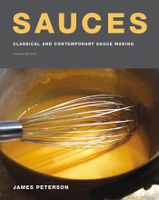Advertisement
Modern Methods for Making Brown Sauces
Appears in
Published 1991
The long-evolved method of making sauces with demi-glace is easy to abuse. The time and money required to prepare classic or unthickened demi-glace can be daunting, and many chefs have not resisted the temptation to use the stockpot indiscriminately for kitchen refuse, including poorly defatted meat trimmings, stale carcasses, and vegetable ends. Indeed, many chefs have gradually replaced the meat in their stocks with bones.
Although bones can contribute body and natural gelatin to a stock and the resulting sauce, they do not supply the necessary savor to a demi-glace thickened with roux. Remember that roux was originally added to stocks as an economy measure; roux-thickened meat stocks were seen as a compromise and replacement for the concentrated sauces of the seventeenth and eighteenth centuries. To make stock with bones and then thicken it with roux is thus a double economy with far from satisfying results. This method has caused chefs to react, often unjustifiably, against demi-glace and sauce espagnole, usually because they have never tasted a correctly made version of either one.

